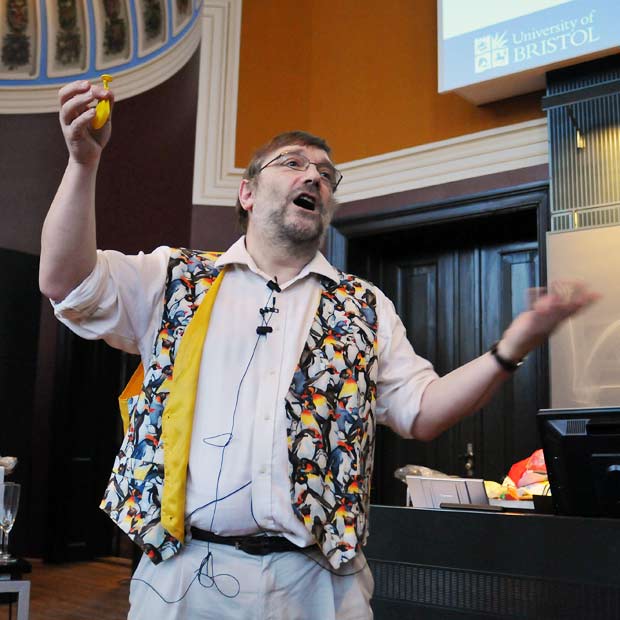
How much does air weigh? With a balloon and a microwave oven you can easily find out says Peter Barham.
Peter Barham’s presentation at the MG seminar in Copenhagen focused on how food can be used to make students interested in physics and chemistry (not a bad thing, especially since 2011 is the International Year of Chemistry) -Most people think science is boring and difficult, he said. But demos can help bring science to life, and believe it or not – experiments are much better when they go wrong. Using balloons, champagne, potatoes and liquid nitrogen Peter Barham proved his point. As an example he asked the audience how much air weighs. He first filled a balloon with a few milliliters of water, then squeezed out all the air, tied a knot and heated the water in the microwave until all had evaporated. The first balloon exploded since he used to much water (this shows that water expands when boiled and that balloons are not infinitely stretchable!). Using a little less water for the second balloon, everything worked fine. Assuming that steam has approximately the same density as air, the size of the balloon can be measured and from this the weight of air be calculated. One finds that the volume of the water increases by a factor of approximately 800x.

There will be more foam when champagne is poured into a dirty glass due to more nucleation sites providing the dissolved carbon dioxide with more escape routes.
Ever heard about how a spoon in the neck of an opened champagne bottle can keep the champagne fizzy? Well unfortunately this is a kitchen myth. The only thing that helps is keeping the bottle cold. The spoon has no effect whatsoever. And the balloon once cooled can help illustrate this. When all the steam had condensed there was a significant amount of gas left in the balloon (remember that all the air was squeezed out to start with). This illustrates that gases are soluble in water at low temperature, but not at higher temperature. When water is boiled the gas escapes. Gas (and in particular carbon dioxide) is more soluble at lower temperatures, and that is the explanation why champagne may retain quite a lot of the fizz if stored cold. The spoon is only there to confuse you!
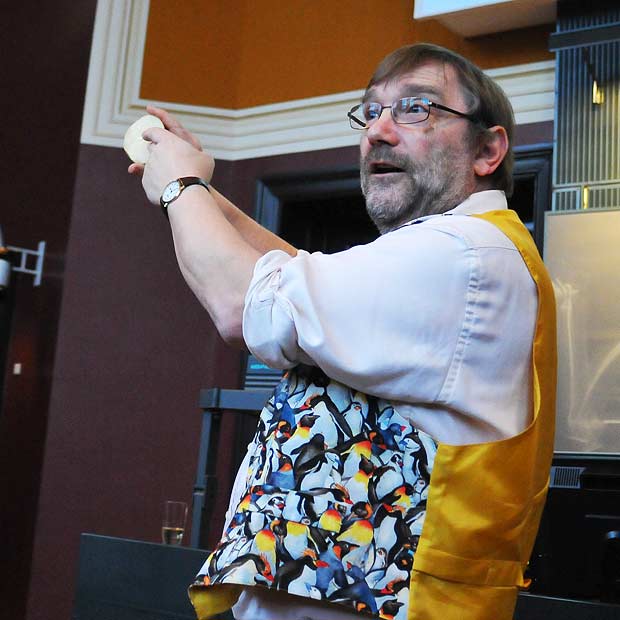
How long does it take to boil a potato?
Next question was: How long does it take to boil potatoes? Since the visual appearance of a potato changes around 60 °C it is possible to monitor heat transfer by simply slicing a potato in two. If boiled in water a nice ring with a slightly darker color indicates how the heat travels uniformely towards the center. If you plot the width of the ring against the square root of the time you get a nice straigth line. However, if heated in a microwave a different pattern emerges. The wavelength of microwaves is on the order of several centimeters and as a consequence the distance between hot and cold areas are about 2 cm. Slicing a microwaved potato shows how only one side has been heated. This is the simple reason why food heated in a microwave oven must be left to stand for a while to allow the heat to diffuse.
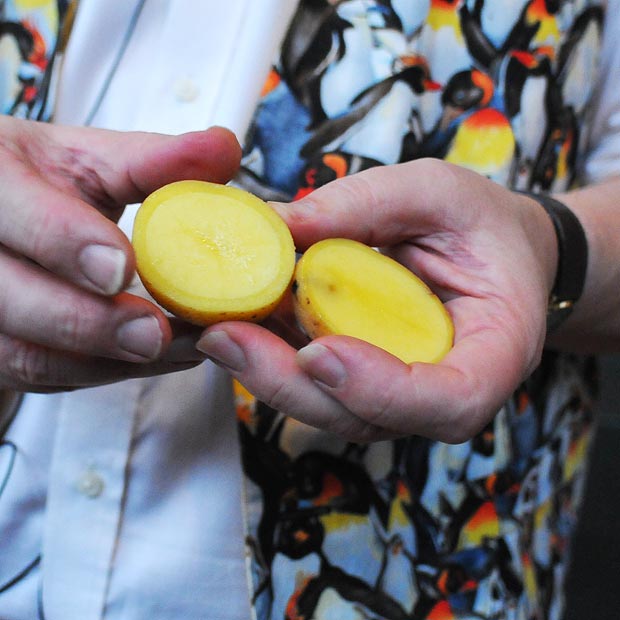
When heated in boiling water the heat travels uniformly towards the center of the potato as evidenced by the “ring” that occurs once the temperature reaches 60 °C.
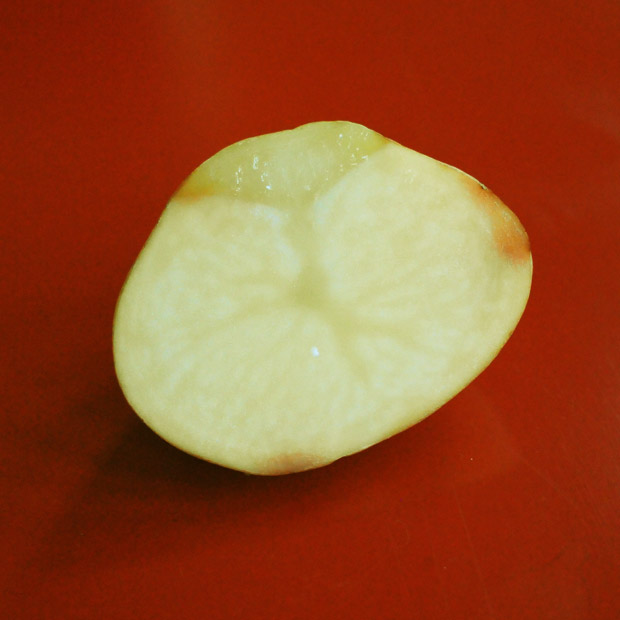
When heated in a microwave there will be hot and cold areas as illustrated with this potato.
Peter Barham also mentioned the experiment that demonstrates the difference between taste and aroma. If you close your eyes, hold your nose and have a friend give you either a piece of apple or pear, you’ll have a difficult task saying which is which. But the second you let go of your nose you recognize what you have in your mouth. The experiment can also be conducted with lemon and lime or other fruit pairs with similar textures. The reason for this is that when you hold your nose, hardly any air from the mouth will enter your nose through the retronasal passage. As a result you will not be able to “smell” what’s in your mouth. But the second you let go of your nose, air can pass freely and you immediately smell what’s in your mouth. This is also the reason why the aroma of food is subdued if you have a cold and a runny nose.
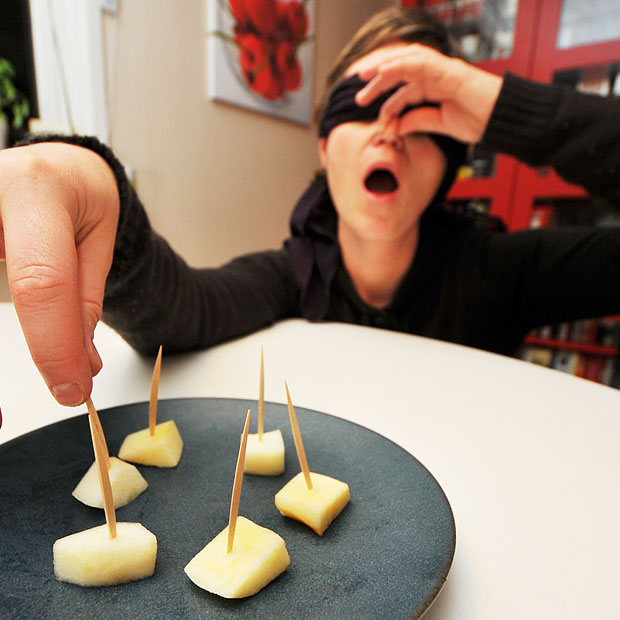
Close your eyes, hold your nose and experience the difference between taste and smell! Apples and pears taste remarkably similar when the aroma is blocked out by holding your nose.
Peter’s last demonstration was liquid nitrogen ice cream and an attempt to break the current world record of 10.34 seconds. More on that in the next post 🙂

Lots of fun here. The aroma-taste experiment can be efficiently conducted using fruit juices of similar taste since this will eliminate texture and most of the mouthfeel differences.
Very neat gas solubility experiment, although you cannot say in what proportion the various gases are dissolved, right? (you’d expectedly have a lot more dissolved CO2 compared to N2 and O2 even though there is much less CO2 in the air, I guess).
How did you calculate 800 X volume increase? If you regard water vapour as an ideal gas it should give around 1300 x, wouldn’t it? (of course water vapour is not an ideal gas).
Hopefully we’ll start seeing MG appearing in educational research journals in not too long, as there is a need to put these things into a (educational) scientific frame as well in addition to more informal “outreach”/”missionary” efforts like this one.
I didn’t do the calculation – the 800x was just a rough number that Peter mentioned. But I guess you could test this with your student’s Erik?
So, if the wavelength of the microwave is a couple of centimeters and this results in uneven heating – why not just build a microwave with two magnetrons, one emitting waves of half the length compared to the other one? That should make everything heat up evenly, no?
John, two magnetrons would cause destructive and constructive interference of the electromagnetic waves and make the uneven cooking worse. There would be extra hot bits and parts that would receive no heat at all!
Microwaves ovens are interesting subjects but wiki seems to be pitched at a Bachelor’s degree level. http://en.wikipedia.org/wiki/Microwave_oven#Principles